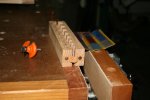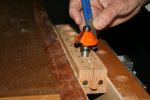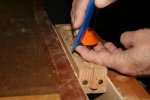glenn bradley
Member
- Messages
- 11,550
- Location
- SoCal
I had responded to someone offline about how I touch up router bits. I thought I would share this here in case it could be helpful.
I made a little jig out of a block of wood to hold various round shafts in my vice. I use a set of E-Z Lap diamond “sticks” which seem to go on sale at Rockler on a regular basis. Even at full price, they’re reasonable. I've been using this set for years.
 .
. 
Just as in sharpening Forstners, you don’t touch the bevel edge unless you are doing repair of a chip or the like. On router bits, if I hit something and knock a corner off the carbide I have to do an assessment as to whether to sharpen or replace but, back to “touch ups”. Use the flat face of the cutter as registration surface. Give two or three swipes to each flute maintaining contact with the flat for guidance. I stroke away from the bevel edge as generally this is easier access-wise.
 .
. 
For edges that have gone too long (or been used on pecan, hickory, wenge and other cutter-eating woods) I may start with the course stick and give two swipes each through the grits. The key here is to do as little as possible. We are just touching up to rid ourselves of that fuzz or burning that can crop up in mid-project. If you find yourself having to do more than just a touch up, send the bits to be sharpened. My ability to remove significant material without setting the bit out of balance is questionable .
.
I made a little jig out of a block of wood to hold various round shafts in my vice. I use a set of E-Z Lap diamond “sticks” which seem to go on sale at Rockler on a regular basis. Even at full price, they’re reasonable. I've been using this set for years.
 .
. 
Just as in sharpening Forstners, you don’t touch the bevel edge unless you are doing repair of a chip or the like. On router bits, if I hit something and knock a corner off the carbide I have to do an assessment as to whether to sharpen or replace but, back to “touch ups”. Use the flat face of the cutter as registration surface. Give two or three swipes to each flute maintaining contact with the flat for guidance. I stroke away from the bevel edge as generally this is easier access-wise.
 .
. 
For edges that have gone too long (or been used on pecan, hickory, wenge and other cutter-eating woods) I may start with the course stick and give two swipes each through the grits. The key here is to do as little as possible. We are just touching up to rid ourselves of that fuzz or burning that can crop up in mid-project. If you find yourself having to do more than just a touch up, send the bits to be sharpened. My ability to remove significant material without setting the bit out of balance is questionable

 I actually have a set of those. Need to make one of your blocks for holding the bits. Thanks!
I actually have a set of those. Need to make one of your blocks for holding the bits. Thanks!